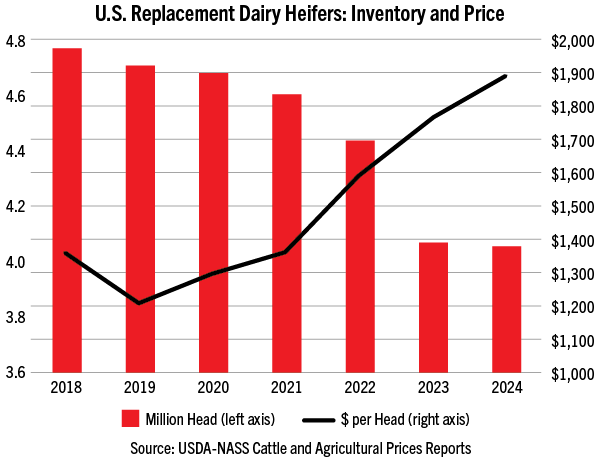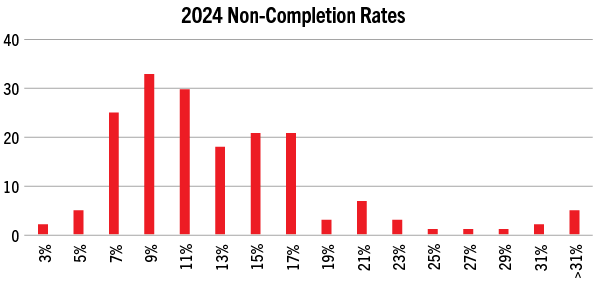- Do you have enough heifer calves to sustain your herd?
- Are your heifer calves healthy and thriving?
The link between cull rate and heifer inventory

The USDA estimates that the dairy heifer inventory is at a 22-year low, with enough replacements to support a national cull rate of 26%. Meanwhile, cull rates on U.S. dairies still average over 30%. We do know that more cows are being kept longer to try
and keep stalls full, but that means profit potential will hinge on health, fertility and efficiency of those older cows. National Association of Animal Breeders (NAAB) reports that 2024 semen sale trends indicate that the heifer shortage is being
felt by some, with a 4% increase in domestic dairy semen sales, however the growth is not enough to make up for the decreases in the previous four years. Many farms are strategically breeding to make 95-100% of their heifer needs in order to capitalize
on beef on dairy calf markets, but do those needs cover the number of high-quality heifers that are needed in the fresh cow pen two and a half years later?
Do you know your dairy's non-completion rate?

Dairy heifer non-completion rate (HNCR) is defined as the percentage of heifers born alive that leave the herd before their first calving. The current Dairy Calf and Heifer Association (DCHA) Gold Standards for HNCR is 10% or less. When analyzing
heifer completion rates, we see a large variability across farms, climates and management systems. In a data set evaluating HNCR in the U.S. we found a wide range. Herds within the data set ranged from 80 to 35,000 cows and included 200 herds
in Arizona, California, Idaho, Indiana, Michigan, Minnesota, North Dakota, Nevada, Ohio, Texas, and Wisconsin. Non-completion rates ranged from 3% to 33%, and loss of heifers before six months ranged from 1% to 25% within the analyzed herds. Differences
in completion rates were not seen between Holstein, Jersey and crossbred herds.
When digging into “when” these potential replacement heifers were exiting dairy herds, three key areas of loss were identified: the first 48 hours, weaning and the breeding pen.
The critical first 48
The first 48 hours of life is the first spike we see in heifer loss. Ensuring that maternity protocols, calving environment, colostrum intake and calf welfare are all top priorities on the dairy can have a substantial effect on the flow of available
replacement heifers. These small details not only minimize the loss of heifers from day-one, but also dictate the health, growth and wellness of the heifer population later on in the pipeline.

Diet and environmental changes
The second spike in loss that we see on most dairy farms is at the weaning stage. This is one of the most stressful and critical phases in a heifer’s life. They are transitioning off milk while also likely experiencing a change in environment.
Many are entering group housing for the first time, trying to ensure adequate intake of new feeds and receiving less one-on-one time than they were experiencing as young calves. These changes can occur on farm and with heifer raisers alike, and
may lead to less thrifty animals falling through the cracks.
Fertility is key
The third area of increased non-completion occurs in the breeding pen as we begin to evaluate heifers as individuals again, making breeding decisions and either synchronizing or watching for heats. These heifers get significantly more individual
evaluation and we begin to identify animals that are not as well grown as the rest of the group. This phase serves as a report card of the heifer’s life over the past year and begins to bring the genetic fertility of the animal to light.
We see clear stratification even in the best heifer raising systems between heifers with better genetics for fertility, specifically Heifer Conception Rate (HCR) and Cow Conception Rate (CCR), and inevitably have to cull some animals who are not in good enough health to become pregnant or unable to do so in the desired window.
The important role of elite genetics
While management is paramount, the role of genetics is also quite evident in heifer populations. As inventories become leaner, focus on calf health and fertility traits is becoming more important to try and get as many heifers to complete
the cycle as possible. Heifers with better values for Calf Wellness Index™ (CW$™), Calf Respiratory Disease, Calf Scours and Calf Livability lead to less treatments and better yields in first lactation animals.
As our industry enters a phase where it becomes a necessity to “milk what you make,” we encourage increased investment and focus in both the management and genetics of the dairy’s calves, which are the future dairy herd. Our consulting teams continue to work diligently to craft customized genetic plans and management systems to ensure the future of our dairy partners.
TAKE HOME POINTS
- Use your genetic advisor to strategically determine the right number of replacements and
ensure that they are sourced from the right females. Your advisor will also account for heifer non-completion rates.
- Heifers who make it to the fresh pen, but face health challenges in the growing period will be less profitable animals.
- Focus on key youngstock milestones: birth, weaning and breeding stages.
- Investments in calf health products and monitoring systems become more profitable as heifer inventories shrink.
- Use a combination of management and genetics to set your dairy up for future success.

These three milestones are critical points in time to focus on regarding the management of heifer health. These periods of growth and development also provide an opportunity to see a large return on investment into animal health products.
Weaning:
AccelAIRate a nutraceutical product formulated to help support the respiratory system
Breeding:
Tri-Mic 1:50 formulated to drive feed intake, enhance feed utilization and growth rates
Tri-Start formulated to benefit both the rumen and intestinal tract